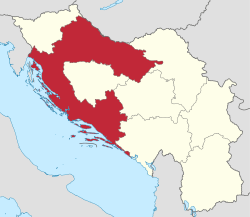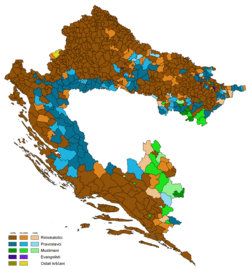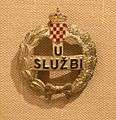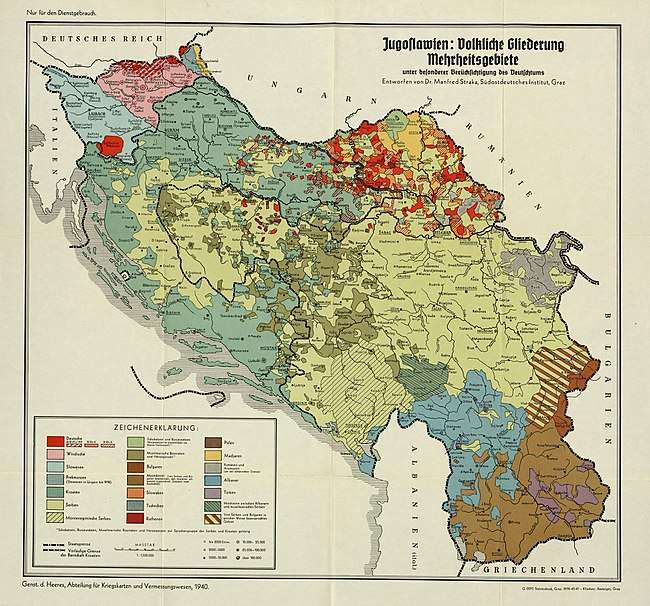Banovina of Croatia
The Banovina of Croatia or Banate of Croatia (Serbo-Croatian: Banovina Hrvatska / Бановина Хрватска) was an autonomous province (banovina) of the Kingdom of Yugoslavia between 1939 and 1941. It was formed by a merger of Sava and Littoral banovinas into a single autonomous entity, with small parts of the Drina, Zeta, and Danube banovinas also included. Its capital was Zagreb and it included most of present-day Croatia along with portions of Bosnia and Herzegovina and Serbia. It had a surface area of 65,456 km2 and a population of 4,024,601 in late 1939. Its sole Ban during this period was Ivan Šubašić.
Banovina of Croatia Banovina Hrvatska | |||||||||||||||||||
|---|---|---|---|---|---|---|---|---|---|---|---|---|---|---|---|---|---|---|---|
| 1939–1941 | |||||||||||||||||||
 Coat of arms
| |||||||||||||||||||
 Banovina of Croatia (red) within Yugoslavia (light yellow) | |||||||||||||||||||
| Status | Banate of Yugoslavia | ||||||||||||||||||
| Capital and largest city | Zagreb | ||||||||||||||||||
| Official languages | Serbo-Croato-Slovene | ||||||||||||||||||
| Government | Banate | ||||||||||||||||||
| Ban | |||||||||||||||||||
• 1939–1941 | Ivan Šubašić | ||||||||||||||||||
| Legislature | Parliament | ||||||||||||||||||
| Historical era | Interwar period World War II | ||||||||||||||||||
| 24 August 1939 | |||||||||||||||||||
• Axis invasion of Yugoslavia | 6 April 1941 | ||||||||||||||||||
| Area | |||||||||||||||||||
| 1939 | 65,456 km2 (25,273 sq mi) | ||||||||||||||||||
| Population | |||||||||||||||||||
• 1939 | 4,024,601 | ||||||||||||||||||
| Currency | Yugoslav dinar | ||||||||||||||||||
| |||||||||||||||||||
| Today part of | |||||||||||||||||||
Background
In the Vidovdan Constitution of 1921, the Kingdom of Serbs, Croats and Slovenes had established 33 administrative districts, each headed by a government-appointed prefect. Both the Vidovdan Constitution in general and the administrative districts in particular were part of the design of Nikola Pašić and Svetozar Pribićević to maximize the power of the ethnic Serb population within the new state.[1] The new constitution was passed in a political climate favorable to the Serbian centralists, as the Croatian regionalists chose to abstain from parliamentary duty, whereas the deputies of the Communist Party of Yugoslavia were excluded by a parliamentary vote.[2] An amendment to the electoral law in June of 1922 further stacked the deck in favor of the Serbian population, when electoral constituencies were created based on pre-war census figures, allowing Serbia to ignore its massive military casualties sustained in the First World War.[3] This only furthered the resentment felt by the proponents of a federate or confederate state towards the government, particularly the Croatian regionalists of the Croatian Republican Peasant Party (HRSS) around Stjepan Radić. Radić was shot in parliament by a Serbian delegate in 1928 and died two months later. This provoked the withdrawal of the HRSS from the assembly, forged an anti-Belgrade mindset in Croatia and ultimately led to the collapse of the constitutional system of the Kingdom of Serbs, Croats and Slovenes.[4][5]
After fruitless efforts to fix the Serb-Croat divide and Croat abstention from government, including a cabinet headed by the nominally neutral Slovene Anton Korošec, King Alexander I of Yugoslavia intervened and, on 6 January 1929, established the 6 January Dictatorship. On 3 October 1929, the country was officially renamed Kingdom of Yugoslavia in an effort to unite the various ethnicities into a greater national identity. The new state had a new constitution, and in place of the 33 administrative districts of the Vidovdan Constitution, it instead established the banovinas. The banovinas were drawn in a way to avoid the old historical, regionalist or ethnic affiliations, but because the King still had a vested interest in maintaining the Serb dominance from which he drew most of his legitimacy as King, six of the nine Banovinas ended up with Serb majorities.[6][7] Instead of uniting Serbs and Croats into a joint Yugoslav identity, there was widespread Croatian resentment against a perceived Serbian hegemony instead.[8]
Over the course of the next ten years, the royal dictatorship grew in strength and ruled with authoritarian decrees,[9] climaxing in the tenure of Milan Stojadinović as Prime Minister between 1936 and 1939. Stojadinović, who had adopted fascist symbolism, gestures and titles from Benito Mussolini in his aspirations to be Yugoslavia's strongman,[10] ultimately fell from grace because he lost the faith of minority representatives in February of 1939.[11] He was replaced by Dragiša Cvetković, who, in an effort to win Croat support for his government, opened talks with Radić's successor as leader of the Croatian regionalists, Vladko Maček. In a compromise named after the two, the Cvetković-Maček Agreement (also known as the Sporazum)[12], the central government made the concession of merging two of the nine banovinas, Sava and Littoral, into one, the Banovina of Croatia.[12][13]
History
On the basis of the Cvetković–Maček Agreement, and the Decree on the Banate of Croatia (Uredba o Banovini Hrvatskoj) dated 24 August 1939, the Banate of Croatia was created.[14] The entire area of the Sava and Littoral Banovinas was combined and parts of the Vrbas, Zeta, Drina and Danube banovinas (districts Brčko, Derventa, Dubrovnik, Fojnica, Gradačac, Ilok, Šid and Travnik) were added to form the Banate of Croatia.[15] The borders of the Banate of Croatia are partly the historical borders of Croatia, and partly based on the application of the principle of ethnicity according to which Bosnian and Herzegovinian territory with a majority Croat population was annexed to the Banate.[14]
Under the Agreement, central government continued to control defense, internal security, foreign policy, trade, and transport; but an elected Sabor and a crown-appointed ban would decide internal matters in Croatia. Ironically, the Agreement fueled separatism. Maček and other Croats viewed autonomy as a first step toward full Croatian independence, so they began haggling over territory; Serbs attacked Cvetković, charging that the Agreement brought them no return to democracy and no autonomy; Muslims demanded an autonomous Bosnia; and Slovenes and Montenegrins espoused federalism. Prince Regent Paul appointed a new government with Cvetković as prime minister and Maček as vice prime minister, but it gained little support.[16] In May 1940, fairly free local elections were held in rural municipalities, showing some weakening of support for Maček and Croatian Peasant Party due to poor economic showing.
In 1941, the World War II Axis Powers occupied Yugoslavia, and establishing a government-in-exile in London. Legally, the Banovina of Croatia remained a part of the occupied Kingdom of Yugoslavia, while the Axis proceeded to dismember Yugoslav territory and the Banovina along with it. Some of the coastal areas from Split to Zadar and near the Gulf of Kotor were annexed by Fascist Italy but the remainder was added to the Independent State of Croatia. As the Kingdom of Yugoslavia became the Democratic Federal Yugoslavia with the success of the Yugoslav Partisans, a new Federal State of Croatia was established within it, succeeding the Banovina.
Population
In 1939, the banovina of Croatia had a population of 4,299,430 of which three quarters was Roman Catholic, one-fifth was Orthodox, and 4 percent was Muslim.[17] The banovina was divided into 116 districts (kotari) of which 95 had an absolute and 5 had a relative Catholic majority.[17]
Sports
The Croatian Football Federation was the governing body of football within the Banovina. It organized a domestic league and a national team. The Banovina of Croatia had four international matches: two pairs of home-and-away matches against Switzerland and Hungary. The Croatian Rowing Championships were held on 29 June 1940.[18]
Croatia men's national ice hockey team played its first friendly game against Slovakia on February 9, 1941 in Bratislava and lost 6-1.[19]
The Croatian Boxing Federation was reconstituted on 5 October 1939 as the governing body of boxing within the entire Banovina of Croatia.[20]
Gallery
 Religious map of the Banovina Croatia by municipality, according to the 1931 census.
Religious map of the Banovina Croatia by municipality, according to the 1931 census. Territory of the Banovina Croatia compared to territory of the present-day countries as well as the prior existing banates.
Territory of the Banovina Croatia compared to territory of the present-day countries as well as the prior existing banates. Banates of the Kingdom of Yugoslavia prior to the establishment of the Banovina of Croatia.
Banates of the Kingdom of Yugoslavia prior to the establishment of the Banovina of Croatia.
 Lesser coat of arms of the Banovina of Croatia
Lesser coat of arms of the Banovina of Croatia
 Ethnic map of Yugoslavia, 1940.
Ethnic map of Yugoslavia, 1940.
See also
Part of a series on the |
|---|
| History of Croatia |
 |
|
Early history
|
|
Middle Ages
|
|
Modernity |
|
Contemporary Croatia |
| Timeline |
|
|
Notes
- Benson, Leslie (2001). Yugoslavia: A Concise History. Hampshire: palgrave macmillan. pp. 34-35. ISBN 0333792416.
The government produced a draft constitution, following intensive consultations between Pasiç and Pribiceviç, which opted for a centralized state with a strong monarchy and a single-chamber parliament, modelled on the Serbian constitution of 1903. Their draft proposed the creation of [33] administrative districts, a balkanizing tactic intended to maximize the electoral power of the Serb vote.
- Jelavich, Barbara (1983). Twentieth Century. History of the Balkans. 2. Cambridge: Cambridge University Press. pp. 150. ISBN 9780521274593.
After the elections the delegates of the Croatian Peasant Party met in Zagreb and decided not to participate in the assembly. As we have seen, the Communist Party was excluded by a vote of the assembly itself. A quarter of the elected representatives thus did not attend. Under these circumstances the Serbian centralists had a clear field, and the constitution, which was completed in June 1921, expressed their interests.
- Benson, Leslie (2001). Yugoslavia: A Concise History. Hampshire: palgrave macmillan. pp. 39. ISBN 0333792416.
Disaffection among the non-Serb nationalities was aggravated by the amended Electoral Law of June 1922, which created electoral constituencies on the basis of pre-war census figures, so that Serbia’s huge population losses during the Great War were ignored.
- Benson, Leslie (2001). Yugoslavia: A Concise History. Hampshire: palgrave macmillan. pp. 45. ISBN 0333792416.
The next day, 20 June 1928, amid familiar scenes of disorder, Raciç opened fire in the debating chamber, killing two deputies and wounding three others, among them Radiç, who died two months later, although initially he seemed to make a good recovery; sufficiently so to maintain his hostility to cooperation with the Serbs.
- Calic, Marie-Janine (2014). A History of Yugoslavia. West Lafayette: Purdue University Press. p. 104. ISBN 9781557538383.
On the morning of 20 June 1928, Stjepan Radić appeared at the opening session of parliament. Although public confrontations in the preceding days had escalated to the point of murder threats, this consummate politician threw caution to the wind. One of the first people to speak that morning was Puniša Račić, a member of parliament for the Radical Party from Montenegro. Quite unexpectedly he found himself in a heated debate with the colleagues from the opposition. The president of the parliament was trying valiantly but unsuccessfully to restore order when Račić suddenly pulled out his pistol and shot in the direction of the Croatian Peasant Party (HSS) faction. Two members of parliament died immediately; two others were wounded. Radić, who had been shot in the stomach, died in August of complications. The assassination marked the tragic culmination of the domestic crisis that had been fatefully escalating since 1927. It turned Radić into a martyr, welded together Croat national politics, and provided the Peasant Party with enormous political capital. However, Yugoslav democracy had shattered, and the king declared a state of emergency.
- Benson, Leslie (2001). Yugoslavia: A Concise History. Hampshire: palgrave macmillan. pp. 53. ISBN 0333792416.
- Calic, Marie-Janine (2014). A History of Yugoslavia. West Lafayette: Purdue University Press. p. 104. ISBN 9781557538383.
- Djilas, Alexis (1991). The Contested Country: Yugoslav Unity and Communist Revolution, 1919-1953. London: Harvard University Press. pp. 81. ISBN 0674166981.
Although some supporters of the dictatorship were genuine Yugoslavists, including, as some evidence suggests, the king himself, Croats inevitably considered the dictatorship as thinly disguised "Serbian hegemony." Indeed, the dictatorship was bitterly resented in Croatia. Instead of dissolving traditional Croatian nationalism, the dictatorship strengthened the extremists.
- Calic, Marie-Janine (2014). A History of Yugoslavia. West Lafayette: Purdue University Press. p. 105. ISBN 9781557538383.
During the royal dictatorship, the country’s unity became its chief priority. King Alexander juxtaposed “tribalism” with Yugoslav “nationalism” in order to overcome internal divisions of different kinds. The regime used draconian royal decrees and the state’s security apparatus to implement national and state unity by dictatorial means. Basic civil rights such as freedom of expression and freedom of association were suspended.
- Benson, Leslie (2001). Yugoslavia: A Concise History. Hampshire: palgrave macmillan. pp. 65. ISBN 0333792416.
Stojadinoviç developed a marked taste for the fascist trappings of power. After meeting with Mussolini, in December 1937, he adopted a version of the Roman salute and took to styling himself ‘Leader’ of his followers, though not, he said with characteristic equivocation when confronted by Prince Pavle about it, with any wish to emulate the Duce, to whom he had said exactly the opposite. Stojadinoviç aspired to be Yugoslavia’s strong man, and because of it he ended up an Axis stooge.
- Benson, Leslie (2001). Yugoslavia: A Concise History. Hampshire: palgrave macmillan. pp. 66. ISBN 0333792416.
Stojadinoviç formed a second administration, but at the beginning of February 1939 his Slovene and Muslim ministerial colleagues, together with Dragisa Cvetkoviç, a Serb, resigned, stating as their reason the government’s intransigence over the Croat problem. Stojadinoviç’s position was now untenable[.]
- Calic, Marie-Janine (2014). A History of Yugoslavia. West Lafayette: Purdue University Press. p. 120. ISBN 9781557538383.
- Djilas, Alexis (1991). The Contested Country: Yugoslav Unity and Communist Revolution, 1919-1953. London: Harvard University Press. ISBN 0674166981.
- Croatian History Museum
- Uredba o banovini Hrvatskoj (in Croatian)
- The Sporazum, Tripartitate Pact, and Outbreak of World War II
- Velikonja (2003), p. 146
- Kronologija hrvatskog veslanja Archived August 13, 2009, at the Wayback Machine
- PREHĽAD ZÁPASOV A-tímu SR od roku 1940 Archived 2013-05-31 at the Wayback Machine
- Povijest hrvatskog sporta: Boks
References
- Velikonja, Mitja (2003). Religious Separation and Political Intolerance in Bosnia-Herzegovina. College Station: Texas A&M University Press. ISBN 9781585442263.
External links
| Wikimedia Commons has media related to Banovina of Croatia. |
- Map of Yugoslav banovinas with the Banovina of Croatia (in Hungarian)
.svg.png)